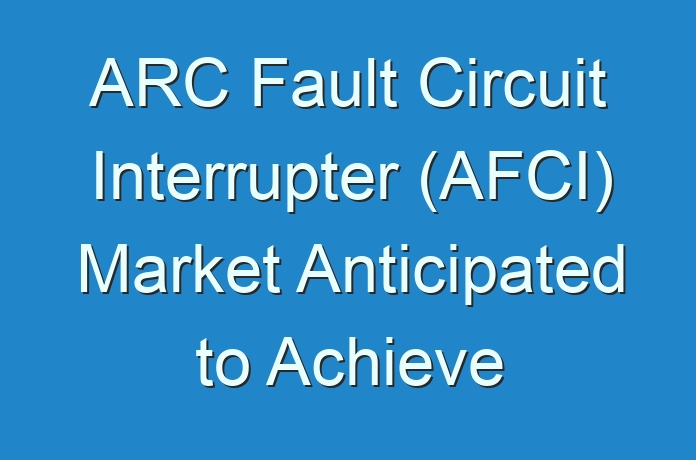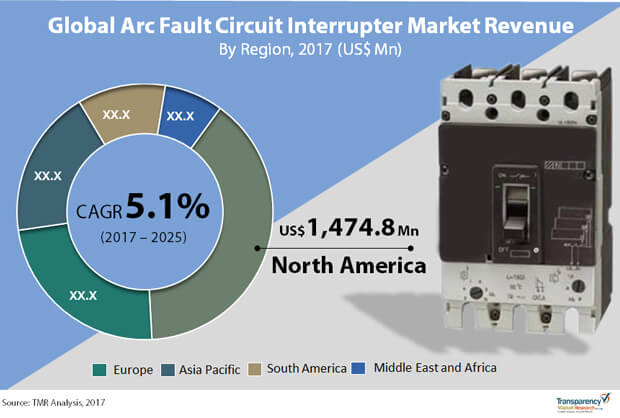
Global Arc Fault Circuit Interrupter Market: Snapshot
Arc fault circuit interrupters are a protective equipment against fires that can occur from sparkling or arcing. Arc faults can arise from poor connections, braches in wires, shorted wires, overheated or stressed electrical wires and cords, deteriorated wires, etc. AFCI are implemented in residential and commercial/industrial applications for detecting dangerous arcs and reducing risks.
The global arc fault circuit interrupters market is expected to exhibit a robust 5.1% CAGR between 2017 and 2025, rising from a valuation of US$3.7 bn in 2017 to close to US$5.6 bn by 2025.
The major factor affecting the growth of the global arc fault circuit interrupter market is the rising safety concern regarding electrical equipment in the residential segment. Arc fault are responsible for house fire incidents, leading to injuries and property damage caused by fire. Therefore the increasing number of these incidents has led to the passing of mandatory requirements for the installation of AFCIs, which will likely effectively diminish such incidents. Demand from the AFCI market is anticipated to increase in the near future due to the rising concern for the safety of commercial buildings and houses. In some countries such as the U.S., Canada, and Germany, mandatory regulations have been passed to implement arc fault circuit interrupters in upcoming and ongoing construction projects, ensuring steady growth of the arc fault circuit interrupters market in the coming years.
Planning to lay down future strategy? Perfect your plan with our report sample here https://www.transparencymarketresearch.com/sample/sample.php?flag=S&rep_id=24962

Branch/Feeder AFCI to Dominate Arc Fault Circuit Interrupter Market
The global arc fault circuit interrupter market has been segmented on the basis of type, fuel type and application. The type segment has further been divided into branch/feeder, outlet, and combination. The branch/feeder segment holds the largest share in the global arc fault circuit interrupter market and is expected to grow at a fast rate in the forecast period. Combination type arc fault circuit interrupters are anticipated to grow at the fastest rate during the forecast period, following the branch/feeder type segment.
On the basis of application, the market has been divided into residential and commercial/industrial. The residential segment is expected to grow at the fastest rate due to the increasing requirement for arc fault circuit interrupters in this application and regulatory compliances made by governments and forums to implement it.
Europe to Emerge as Significant Contributor, North America to Dominate
The global arc fault circuit interrupter market is expected to be driven by the North America region. The regional market was valued at close to US$1.5 bn in 2017, nearly twice as much as any other regional AFCI market, and is likely to exhibit the fastest CAGR of 5.6% till 2025 to emerge with a valuation of close to US$2.3 bn. Europe is estimated to contribute a major share in the overall AFCI market over the 2017-2025 forecast period, closely followed by Asia Pacific. The two markets are expected to exhibit a 5.2% and 4.9% CAGR over the forecast period, respectively, and both are likely to be valued at over US$1 bn by 2025. Meanwhile, South America and the Middle East and Africa are anticipated to grow at a relatively sluggish rate during the forecast period.
Looking for exclusive market insights from business experts? Request a Custom Report here https://www.transparencymarketresearch.com/sample/sample.php?flag=S&rep_id=24962
Key players profiled in the global arc fault circuit interrupter (AFCI) market include Eaton Corporation, General Electric, Siemens Industry, Inc., Legrand SA, Schneider Electric SE, and Leviton Manufacturing Co.
Several companies are focusing on the advancement of arc fault circuit interrupter devices due to the growing regulatory support to adoption of the same across the residential sector. Further, companies are introducing analysis tools for pinpointing the type of tripping and also offering dual combinations of AFCI and GFCI in a single unit to minimize the risk posed by AFCI mishaps. This is likely to remain a key trend in the global arc fault circuit interrupter market in the coming years.





